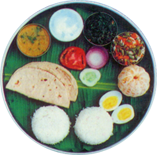Dietary goals and guidelines
Dietary goals and guidelines
Introduction
Adequate intake of all the essential nutrients through a well formulated balanced diet is needed to maintain good health. Nutrition plays an important role right from the time of the baby's presence in the mother's womb till he/she reaches old age. A balanced diet prevents all the adverse effects of nutritional deficiencies and also ensures optimal growth and development. It also minimizes the risk of diet related non- communicable diseases (DR-NCDs) occurring in later life. Sound optimal nutritional status of mother and child during the first 1000 days of life, starting from the conception till the child completes two years of age is closely linked to growth and learning in the initial stages of development and to the reduced risk of metabolic syndrome, diabetes and cardiovascular diseases later in life. Appropriate dietary habits and physical activity through all the stages of one's life are essential for the maintenance of holistic health.
A balanced diet fulfils all the nutritional needs of the body. There is no single food which can provide all the necessary nutrients and hence these need to be obtained through a judicious choice of a variety of foods. Such diets also provide a host of other bioactive substances and phyto- nutrients and thus exert a positive impact on health. Appropriate dietary habits promote optimal growth and development and prevent malnutrition occurring in all its forms-undernutrition, micronutrient deficiencies, overweight, obesity (including abdominal/central obesity) and DR-NCDs.
Dietary Goals

- Maintenance of a state of positive health and optimal performance in populations at large by maintaining ideal body weight.
- Ensuring adequate nutritional status for pregnant women and lactating mothers.
- Improvement of birth weights and promotion of growth of infants, children and adolescents to achieve their full genetic potential.
- Achievement of adequacy in all nutrients and prevention of deficiency diseases.
- Prevention of chronic diet-related disorders.
- Maintenance of the health of the elderly and increasing the life expectancy.
Dietary Guidelines - A broad framework for action
Right nutritional behavior and dietary choices are needed to achieve dietary goals. The following 17 dietary guidelines provide a broad framework for appropriate action:
- Eat variety of foods to ensure a balanced diet.
- Ensure provision of extra food and healthcare to pregnant and lactating women.
- Promote exclusive breastfeeding for six months and continue breastfeeding till two years and beyond.
- Start feeding homemade semi-solid complementary foods to the infant soon after six months of age.
- Ensure adequate and appropriate diets for children and adolescents, both in health and sickness.
- Eat plenty of vegetables and legumes.
- Use oils/fats in moderation; choose a variety of oilseeds, nuts, nutricereals and legumes to meet daily needs of fats and essential fatty acids (EFA).
- Obtain good quality proteins and essential aminoacids (EAA) through appropriate combination of foods and avoid protein supplements to build muscle mass.
- Adopt a healthy lifestyle to prevent abdominal obesity, overweight and overall obesity.
- Be physically active and exercise regularly to maintain good health.
- Restrict salt intake to minimum.
- Consume safe and clean foods.
- Adopt appropriate pre-cooking and cooking methods.
- Drink adequate quantity of water.
- Minimize the consumption of high fat, sugar, salt (HFSS) and ultra processed foods (UPFs).
- Include nutrient-rich foods in the diets of elderly people for health and wellness.
- Read information on food labels to make informed and healthy food choices.
Source: National Institute of Nutrition, Hyderabad
Related resources
Last Modified : 5/22/2024
This topic provides information about Yogic Diet f...
This topic deals with information related to Ulcer
This topic covers the treatment options for Celiac...
This page described about Thyroid.
